The Business Case for Programmatic Social Advertising for EV Marketing
The Electric Vehicle (EV) market is growing rapidly, fueled by evolving technology and increased consumer awareness of climate change. As a result, potential customers have become more discerning, and their purchase journey more digital. The need for programmatic social advertising in this context arises from three main areas:
![]() Increased Competition. With more players entering the EV market, differentiation and effective brand communication have become critical. Programmatic social advertising helps precisely target a brand’s specific customer personas, enhancing the reach and relevance of marketing efforts.
Increased Competition. With more players entering the EV market, differentiation and effective brand communication have become critical. Programmatic social advertising helps precisely target a brand’s specific customer personas, enhancing the reach and relevance of marketing efforts.
![]() Educating the Consumer. EVs are relatively new to the automotive market, and potential customers often have questions about range, charging, cost, and maintenance. Programmatic advertising enables brands to deliver tailored educational content to address these questions and reduce barriers to purchase.
Educating the Consumer. EVs are relatively new to the automotive market, and potential customers often have questions about range, charging, cost, and maintenance. Programmatic advertising enables brands to deliver tailored educational content to address these questions and reduce barriers to purchase.
![]() Brand Building and Loyalty. Due to the nascent nature of the EV market, consumers are yet to form strong brand associations. By leveraging personalized advertising to engage with consumers throughout their purchase journey, brands can build stronger relationships and foster loyalty.
Brand Building and Loyalty. Due to the nascent nature of the EV market, consumers are yet to form strong brand associations. By leveraging personalized advertising to engage with consumers throughout their purchase journey, brands can build stronger relationships and foster loyalty.
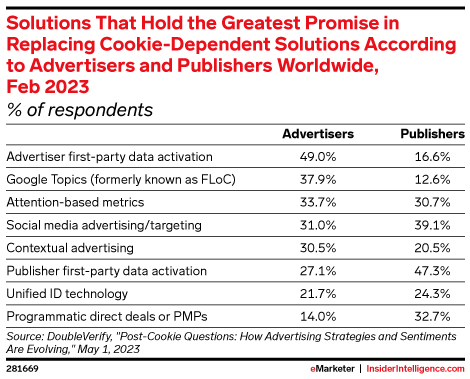
Why this data important for omnichannel media planning? First-party data activation holds the greatest promise among cookieless solutions for advertisers and publishers, respectively. This underlies more intimate partnerships between buyers and sellers capitalizing on first-party assets.
 Approach
Approach
Harnessing the power of social media, our team created a digital ecosystem that resonates with our key audiences. Drawing on emerging trends and market insights, we used storytelling to share an EV brand’s unique journey, highlighting their commitment to sustainability, and inviting their audience to be part of this exciting evolution in automotive history.
![]() Defining Audience Segments. Based on customer data, we created detailed personas of potential EV buyers. This could range from environmentally conscious consumers, tech enthusiasts, luxury car buyers, and early adopters.
Defining Audience Segments. Based on customer data, we created detailed personas of potential EV buyers. This could range from environmentally conscious consumers, tech enthusiasts, luxury car buyers, and early adopters.
![]() Creating Tailored Content. We developed content that addresses the needs, questions, and interests of each segment. This can range from educational content about EV technology to showcasing luxury features or superior performance.
Creating Tailored Content. We developed content that addresses the needs, questions, and interests of each segment. This can range from educational content about EV technology to showcasing luxury features or superior performance.
![]() Leveraging Advanced Programmatic Techniques. We deployed advanced techniques like real-time bidding, automated A/B testing, and dynamic content optimization to ensure our content reaches the right audience at the right time, and continually improve performance.
Leveraging Advanced Programmatic Techniques. We deployed advanced techniques like real-time bidding, automated A/B testing, and dynamic content optimization to ensure our content reaches the right audience at the right time, and continually improve performance.
![]() Engaging Throughout the Purchase Journey. We used retargeting and sequential messaging to engage with consumers at each stage of their purchase journey, from initial awareness and consideration to purchase and post-purchase support.
Engaging Throughout the Purchase Journey. We used retargeting and sequential messaging to engage with consumers at each stage of their purchase journey, from initial awareness and consideration to purchase and post-purchase support.
 Strategic Considerations
Strategic Considerations
Tailored to the specific EV brand client, our strategic considerations:
Brand Awareness & Key Differentiators: We used the EV brand’s key differentiators in design, performance, and intelligence to elevate our storytelling, using a blend of organic and paid social content. This involved creating visually appealing, engaging content about our vehicles, their features, and their impact on the environment, supported by AI-generated creatives to enhance resonance. We leaned into the sustainability narrative, positioning the EV brand as a leader in the green revolution.
Investor Relations & Press Releases: We used platforms like LinkedIn and Twitter for investor communications and press releases, sharing updates about company milestones, financial performance, and strategic initiatives. We also use these channels to highlight executive thought leadership, reinforcing the EV brand’s position as an industry innovator.
Event Marketing: We used Instagram, Facebook, and Twitter for event marketing, using features like Live Video during launches, behind-the-scenes tours, or Q&A sessions. These platforms offer advertising formats to help drive event attendance and engagement.
Crisis Management: We used social listening tools to detect potential issues early, with a robust response plan in place to mitigate damage. This involved clear lines of communication and responsibility within the team, and proactive outreach to affected parties where necessary.
Subscription Management & Social Customer Service: We managed subscriptions through platforms like Facebook, allowing customers to opt-in for regular updates about the EV brand. Social platforms also served as a critical customer service channel, with dedicated/delegated resources to address queries and concerns in real-time.
Social Analytics, Social Listening, & Share of Voice: We used AI-powered tools to analyze our performance across metrics like engagement, reach, and sentiment, and to understand share of voice in the electric vehicle conversation. This data informs content strategy and enable us to adapt quickly to changing trends or sentiment.
KPIs & Measures of Success: We tracked KPIs including follower growth, engagement rate, share of voice, and conversion rate. Success is measured by our ability to increase brand awareness, drive website traffic, and ultimately, increase sales.
Content Strategy & Social Editorial Calendar: Our content vary by platform to cater to different audience preferences. We maintain a social editorial calendar to ensure a steady flow of engaging, relevant content, including product highlights, user-generated content, sustainability stories, and executive thought leadership. The most successful editorial calendars are consumer-driven. We use a similar data below to understand media consumption.
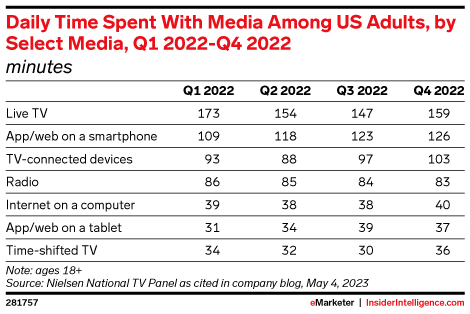
Our editorials and media plans adapt to changes in performance, demand, and market conditions. Here, we see US adults spend more time with live TV than any other form of media, according to Nielsen. Live TV is followed by smartphones and TV-connected devices in time spent.
Analytics & Campaign Measurement: We use advanced analytics to understand campaign performance in real-time, enabling us to iterate quickly and optimize our content and targeting strategies. We leverage AI tools to generate actionable insights from our data.
Creative Direction & Production: Creative direction focused on highlighting the unique design and performance of the EV brand’s vehicles, using high-quality visuals and compelling narratives. We also leverage AI to generate and optimize creatives, and to test different content variations.
Team Leadership: Our social media team is a meticulously designed to be cross-functional, bringing together skills in content creation, community management, analytics, and social customer service. We foster a culture of innovation, encouraging team members to experiment and iterate.
International Policy Considerations, GDPR, and Other Laws: We ensure our social media practices comply with international privacy and data protection laws, including GDPR. This involve working closely with brand and legal teams to understand any platform or region-specific requirements.
Engagement Strategy: We use gamification, user-generated content, and interactive content like infotainment, quizzes or polls to drive engagement. We also engage with comments and direct messages in a timely manner to foster a sense of community.
Recommended Social Networks & Ad Formats: We focus on platforms including Instagram, Facebook, Twitter, LinkedIn, and YouTube, using a mix of image, video, carousel, and stories ads. Our omnichannel media strategy informs this.
Omnichannel Media Plan: We allocate our media budget across platforms and ad formats based on their performance and our audience preferences. We continually reassess our media plan based on campaign performance and market trends. Below is a sample data helping us do this task effectively.

Why is this data important for omnichannel media planning? First-party data activation holds the greatest promise among cookieless solutions for advertisers and publishers, respectively. This underlies more intimate partnerships between buyers and sellers capitalizing on first-party assets.
Brand Associations: We’ll seek partnerships with influencers and organizations that align with our brand values, using these relationships to expand our reach and credibility.
Audience Segment Strategy: We’ll create tailored content for key audience segments, including tech enthusiasts, environmentalists, luxury consumers, and potential investors. This will involve creating persona-specific messaging and using platform targeting capabilities to reach the right audience with the right message.
Age Range or Classification Based on Intent to Buy: Our primary audience will be adults aged 25-55, but we’ll also target younger audiences to build brand affinity and reach potential future customers. We’ll use platform targeting capabilities to reach these audiences based on their intent to buy a car.
Why are we focusing on social media to nurture relationships with existing owners, investors, and those who aspires to drive their own EVs in the future?
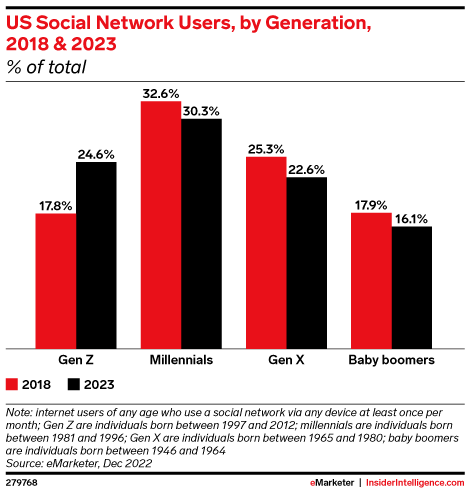
Gen Z will make up almost one-quarter of US social users. In another first, there will be more Gen Z than Gen X monthly social users in the US in 2023. To put it another way, there are now almost 20 million more US Gen Z social users than there were in 2018, when ByteDance merged Musical.ly with TikTok and the app started to take off in the US. As Gen Z grows up (the oldest members will turn 26 this year), their social media preferences and habits will transform the US social landscape.
The success of our programmatic social advertising strategy was evaluated on several key performance indicators:
![]() Brand Awareness: Increase in brand search volume, brand mentions on social media, and audience reach of our advertising campaigns.
Brand Awareness: Increase in brand search volume, brand mentions on social media, and audience reach of our advertising campaigns.
![]() Customer Engagement: Increase in engagement metrics such as likes, shares, comments, and click-through rates on our social media posts and ads.
Customer Engagement: Increase in engagement metrics such as likes, shares, comments, and click-through rates on our social media posts and ads.
![]() Lead Generation: Increase in the number of leads generated through social media, measured through metrics like form completions, newsletter signups, and booking test drives.
Lead Generation: Increase in the number of leads generated through social media, measured through metrics like form completions, newsletter signups, and booking test drives.
![]() Sales: Increase in direct sales attributed to our social media campaigns, measured through tracking pixels and multi-touch attribution modeling.
Sales: Increase in direct sales attributed to our social media campaigns, measured through tracking pixels and multi-touch attribution modeling.
![]() Customer Education: Reduction in common queries about EVs as consumers become more educated, measured through social listening and customer service interactions.
Customer Education: Reduction in common queries about EVs as consumers become more educated, measured through social listening and customer service interactions.
![]() Customer Loyalty: Increase in repeat purchases and positive brand sentiment among existing customers, measured through customer surveys and net promoter scores.
Customer Loyalty: Increase in repeat purchases and positive brand sentiment among existing customers, measured through customer surveys and net promoter scores.
Where engagements matter:
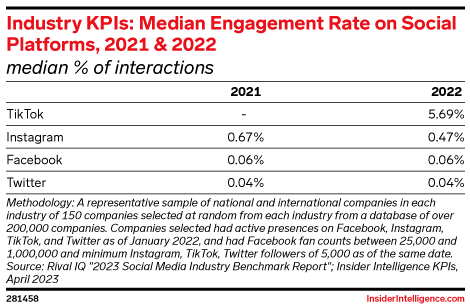
Median engagement rate allows for understanding what’s trending by platform.
What impacts the social media calendar:
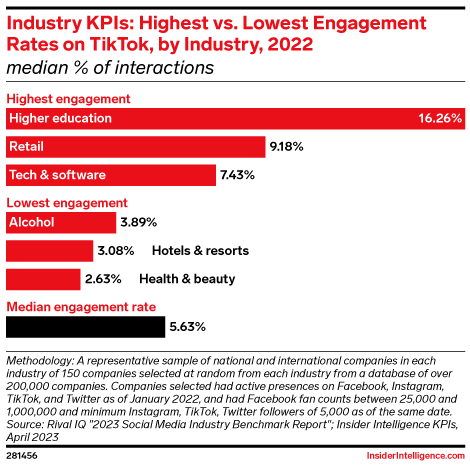
Engagement rates differ wildly by category and by platform, so it’s important to understand both to put campaign performance in context.
What impacts ad environment choice and budget recommendations:
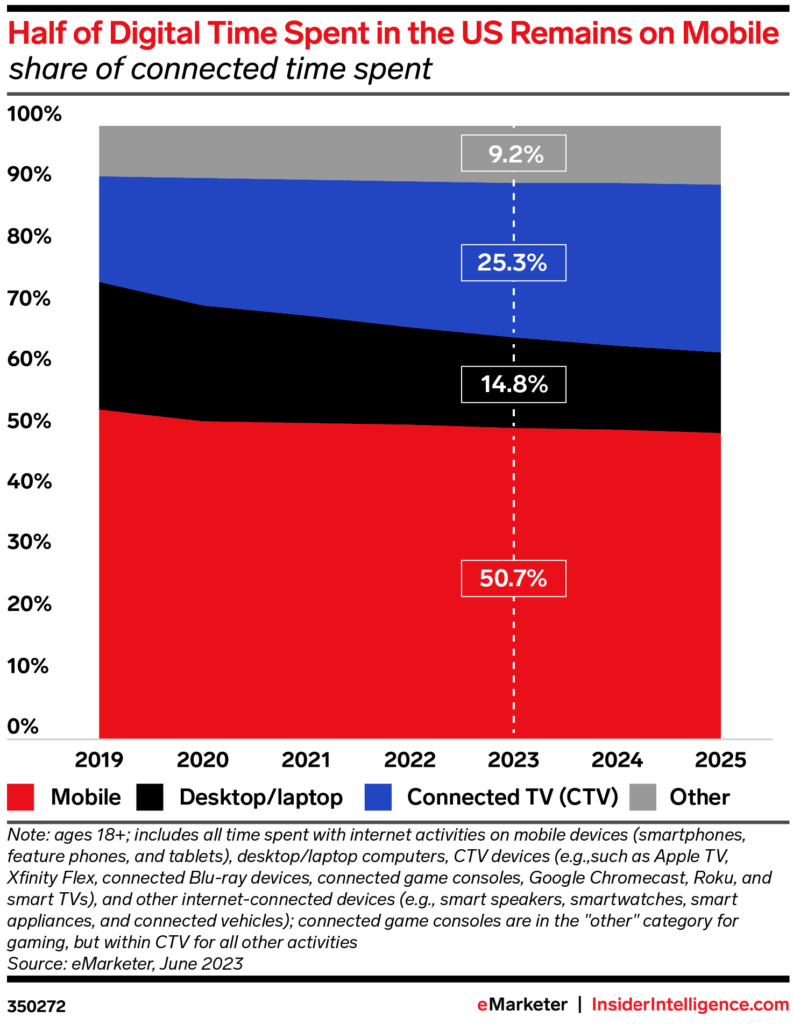
Mobile remains a jack of all trades. About a third of US adults’ daily mobile time will be spent watching video, including short videos on social platforms. But they will also spend over 30 minutes using social media for nonvideo activities, 42 minutes listening to digital audio, and more than 20 minutes each gaming and messaging.



